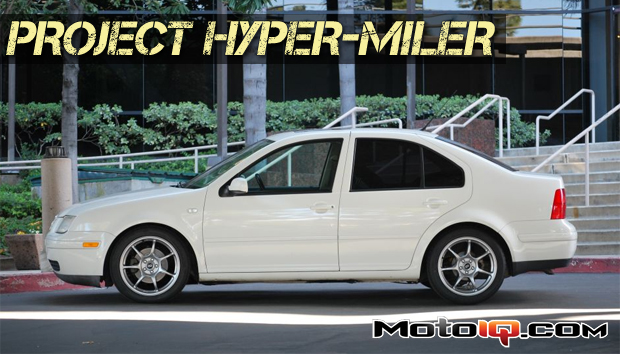,
The rear bar install is very straightforward, and even has the bonus of replacing one of the TTY bolts that hold the bottom of the shock on. All hardware provided are nylocks, which are a suitable replacement for the stock TTY bolts without concern of the fasteners working loose over time. Even still, Whiteline recommends re-torquing the fasteners on a periodic basis.
 |
| The rear Whiteline sway bar installed. To adjust its spring rate, simply move the end link forward or backwards on the sway bar itself. You can just make out the different holes in the end of the bar to accomodate this. |
The front, however, was a fairly involved install. The front bar on a MKIV Jetta installs on top of the subframe, meaning you have to remove it from the car to swap out the bar. As usual, this involves purchasing more TTY bolts for the car, but isn’t nearly as bad a job as it initially appears. Simply unbolt the three 13mm bolts that hold the steering rack on, unbolt the exhaust hanger, the rear dogbone mount, and then remove the 4 bolts holding the subframe itself on. Removing the subframe is not necessary, simply pulling it 4″ or so away from the car is all that is needed. After the subframe is spaced away, remove the two 13mm bolts that hold the swaybar mounts on, then remove the endlinks. Install is reverse of removal, with just a little figuring needed to orient the Whiteline bar correctly (since it doesn’t install exactly the same as stock). The rear bar was set to the firmest setting on install.
 |
| The Whiteline front sway bar installed. Note that the sway bar now goes under the axle instead of over it. The stock endlink was surprisingly still good, and was re-used. |
To complete Hypermiler’s handling upgrades, 17×7.5″ Enkei Fujin wheels in a 40mm offset were wrapped in Nitto Motivo tires in the popular 225/45-17 size. All Enkei wheels are formed using the Most Advanced Technology (MAT) process to ensure excellent strength and weight savings much like a forged wheel, but at a lower price point similar to that of a cast wheel. By using high pressure to cast the wheel’s basic shape, Enkei ensures that there are less voids, allowing for more consistent density and grain structure than can be found in a gravity cast wheel. The MAT process finishes the wheel by forming the wheel’s rim section by spinning the wheel blank through rollers rather than simply machining it to final dimensions. The cold working during the MAT process refines the aluminum’s grain, increases tensile strength, adds compressive stress capability, and orients the grain flow in the proper orientation for the stresses a wheel will see during use.




